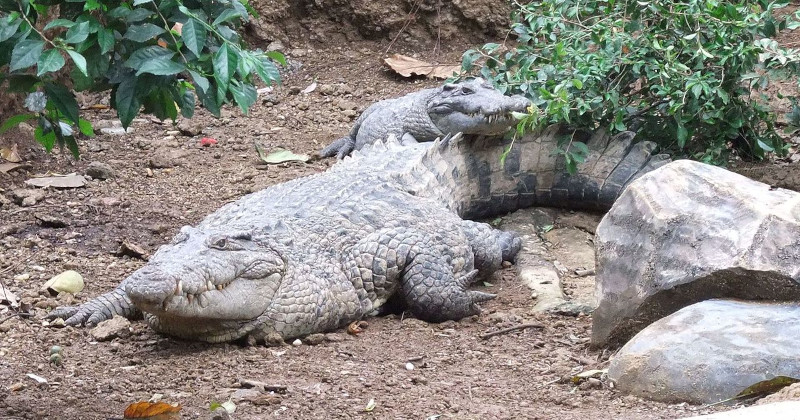New Guinea Crocodile Facts
- This impressive, reclusive reptile most frequently goes by the informative common name of the New Guinea Crocodile. It also possesses several alternate monikers, though. These include such diverse terms as Singapore large grain and Buaya air tawar.
- Most professionals, such as researchers, typically refer to it by its formal, scientific name, however. That, though, is another of the tongue-twisting terms so prevalent in the field. This wonder bears the technical name of the Crocodylus novaeguineae.
- The American herpetologist, Karl Patterson Schmidt made the first formal recognition of the animal as a separate and distinct species. This scientifically noteworthy deed occurred in the year 1928. Experts previously considered it a subspecies, but no longer.
- Thankfully, this marvel of Nature appears to be maintaining a population base across its range that’s both sizeable and stable. This further seems to hold true despite the past depredations inflicted upon its population by mankind, prior to conservation efforts.
- Due to these fortunate factors, it holds a status all too rare these days. That’s because the IUCN currently lists the New Guinea Crocodile as a Species of Least Concern. That status is reflected in the organization’s published Red List of Threatened Species.
- This reptilian wonder nevertheless faces potential threats. These, though, are those shared to various degrees by most species. Habitat degradation and loss, due to human expansion remain real threats. Its greatest danger, though, is likely climate change.
Related Articles
New Guinea Crocodile Physical Description
Like most of its relatives, the dazzling New Guinea Crocodile easily impresses those who encounter it. It manages to do so despite one fact, though. That’s due to the fact that it ranks as a small variety of crocodilian. That, however, still leaves it ranked as a large reptile.
The remarkable animal also follows another pattern held to by most of its brethren. That holds true due to the fact it displays a moderate degree of sexual dimorphism. In its specific case, though, this physiological characteristic manifests itself in terms of sheer size.
More specifically, the males of the species attain a larger physical length than their female counterparts. The males reach a maximum known length measuring as much as 11 ft (3.5 m). These same individuals further reach weights equaling as much as 650 lb (295 kg).
The females, meanwhile, grow only about 8.9 ft (2.7 m). These tend to have a somewhat stockier build than males, though. Despite the difference in length, the two genders attain approximately the same weight. Most, of either sex, though, remains somewhat smaller.
The body of the New Guinea Crocodile presents an intriguing design. Its color scheme ranges from brown to dark gray. It also presents dark bands on both the body and the tail. These, however, generally tend to become less obvious as the individual grows in size.
Its snout widens as the individual ages, begninning life much narrower in construction. An intriguing characteristic further sets it apart from its relatives. Lengthwise ridges near the eyes, and a set of granular scales on the neck form a pattern unique to the species.
- Kingdom: Animalia
- Phylum: Chordata
- Class: Reptilia
- Order: Crocodilia
- Family: Crocodylidae
- Genus: Crocodylus
- Species: C. novaeguineae
New Guinea Crocodile Distribution, Habitat, and Ecology
Unfortunately, both for the animal itself, as well as those of us who appreciate Nature, the New Guinea Crocodile evolved as native to an extremely limited area. That region of the globe lies within a portion of the southwestern Pacific Ocean. It’s better known as Oceana.
As its very name suggests, that zone of habitation falls within the boundaries of the island of New Guinea. That location futher lies roughly 93 mi (150 km) from the continent of Australia. Even there, though, it only lives in the more northern section, especially inland.
Within that limited area, however, it makes the most of its opportunities. That’s due to the fact that it makes its home in several different types of ecosystems. These consist of regions of marshes and swamps, as well as many of the lakes found in that part of the island.
Though individuals rarely venture into areas close to the coast, it does happen on occasion. There, it survives in partially brackish waters, where the freshwater and sea partially combine. Yet, the animal never appears in areas where the larger Saltwater Crocodile lives.
Like most of its related creatures, the magnificent New Guinea Crocodile evolved as a primarily aquatic species. It’s also principally a nocturnal animal. Individuals typically spend the majority of the day underwater, with only their eyes and nostrils above the surface.
It also feeds opportunistically, as others of its kind. The diet mainly consists of various fish species, of course. Nonetheless, individuals consume virtually any prey of sufficient size it encounters. In addition to fish, this includes frogs, crabs, snakes, shrimp, birds, and others.
Species Sharing Its Range
Check out our other articles on 7 Deceptively Dazzling Deserts, Striped Dolphin, Padirac Cave, Texas Blind Salamander, Asian Weaver Ant, Strawberry Tree, Oceanic whitetip shark, Gila Monster

